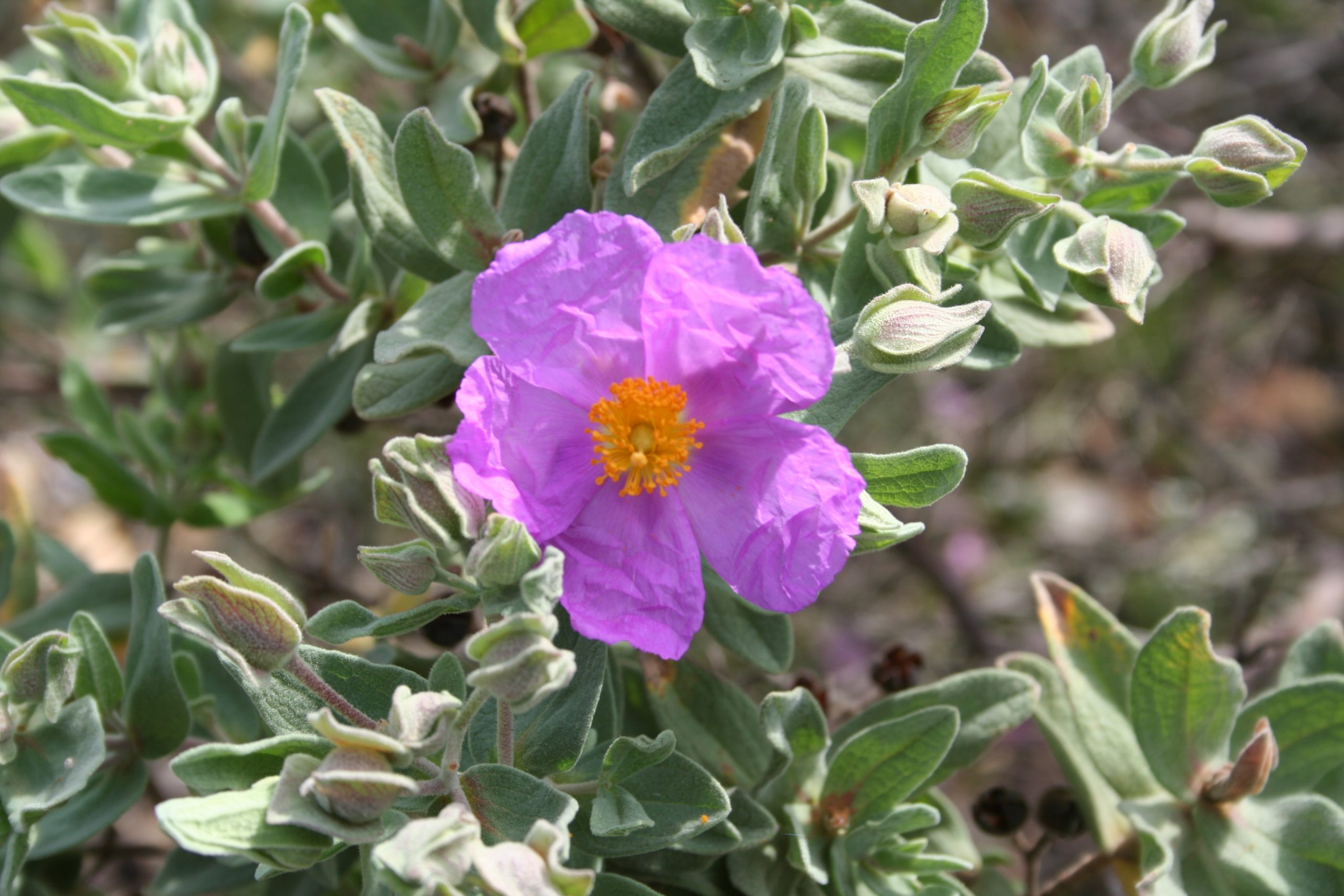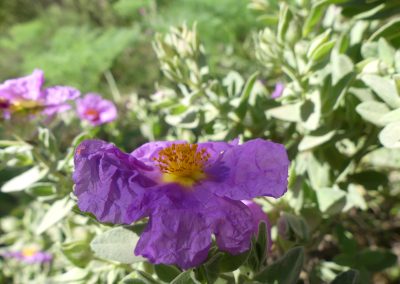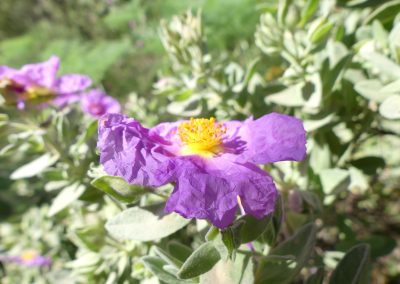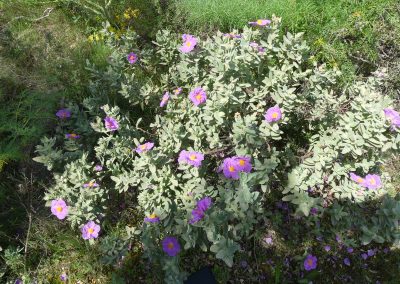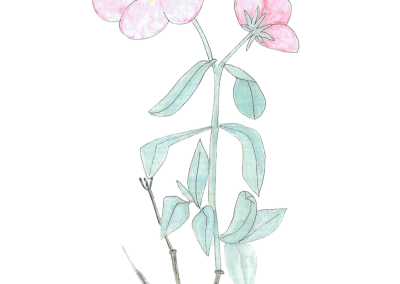Cistus albidus
Scientific description
Taxon: Cistus albidus
Class: Dicotyledons (Magnoliopsida)
Subclass: Rosids
Order: Malvales
Family: Cistaceae
Common name: Grey-leaved rockrose / Downy rockrose
Origin:
Western Mediterranean region.
Description:
Cistus albidus is a perennial shrub, generally low and branched, measuring 0.5–1.5 m in height. Its elongated leaves are covered with a fine whitish down, hence the name “albidus.” It produces large solitary flowers with five broad petals, pale pink to lilac, often spotted with purple at the base. Flowering extends from spring to early summer. A typical Mediterranean maquis plant, it prefers dry, rocky, and well-drained soils. Aromatic foliage emits a characteristic resinous scent. Well adapted to fires, regenerates via seed germination and resprouting.
Propagation:
By seeds, often favored by fires (germination stimulated by heat). Underground shoots also possible.
Ecology:
Pioneer species of Mediterranean maquis, tolerant of drought, wind, and poor soils. Plays a role in soil stabilization.
Use:
Ornamental for dry gardens, source of fragrant resins used in traditional perfumery.
Threats:
Globally not very threatened but locally affected by habitat destruction and urbanization.
Taxon : Cistus albidus
Classe : Dicotylédones (Magnoliopsidées)
Sous-classe : Rosidées
Ordre : Malvales
Famille : Cistacées
Nom commun : Ciste à feuilles blanchâtres / Ciste cotonneux
Origine :
Région méditerranéenne occidentale.
Description :
Cistus albidus est un arbuste vivace, généralement bas et ramifié, de 0,5 à 1,5 m de hauteur. Ses feuilles allongées sont couvertes d’un fin duvet blanchâtre. Il produit de grandes fleurs solitaires avec cinq pétales larges, rose pâle à lilas, souvent tachées de pourpre à la base. Floraison du printemps au début de l’été. Plante typique du maquis méditerranéen, préférant sols secs, rocailleux et bien drainés. Feuillage aromatique dégageant une odeur résineuse. Bien adaptée aux incendies, régénération par graines et rejets.
Propagation :
Par graines, souvent favorisée par les incendies (germination stimulée par la chaleur). Rejets souterrains possibles.
Écologie :
Espèce pionnière du maquis méditerranéen, tolère sécheresse, vent et sols pauvres. Joue un rôle dans la stabilisation des sols.
Utilisation :
Ornementale pour jardins secs, source de résines odorantes utilisées en parfumerie traditionnelle.
Menace :
Peu menacée globalement, mais localement affectée par la destruction des habitats et l’urbanisation.
Taxon: Cistus albidus
Clasă: Dicotiledonate (Magnoliopsida)
Subclasă: Roside
Ordin: Malvales
Familie: Cistaceae
Denumire populară: Cistus cu frunze albicioase / Cistus pufos
Origine:
Regiunea mediteraneană vestică.
Descriere:
Cistus albidus este un arbust peren, scund și ramificat, de 0,5–1,5 m înălțime. Frunzele alungite sunt acoperite cu un puf fin albăstrui. Produce flori mari, solitare, cu cinci petale late, roz pal până la liliachiu, adesea pătat cu purpuriu la bază. Înflorește primăvara până la începutul verii. Plante tipică a maquisului mediteranean, preferă soluri uscate, stâncoase și bine drenate. Frunziș aromatic. Adaptată la incendii, se regenerează prin semințe și lăstari.
Propagare:
Prin semințe, favorizată adesea de incendii (germinare stimulată de căldură). Lăstari subterani posibili.
Ecologie:
Specie pionieră a maquisului mediteranean, tolerantă la secetă, vânt și soluri sărace. Rol în stabilizarea solului.
Utilizare:
Ornamental pentru grădini uscate, sursă de rășini parfumate folosite în parfumeria tradițională.
Amenințări:
Puțin amenințată global, dar afectată local de distrugerea habitatelor și urbanizare.
Ταξινόμηση: Cistus albidus
Κλάση: Δικοτυλήδονα (Magnoliopsida)
Υποκλάση: Ροσίδες
Τάξη: Malvales
Οικογένεια: Cistaceae
Κοινό όνομα: Κίστος με λευκοπράσινα φύλλα / Απαλός κίστος
Προέλευση:
Δυτική Μεσογειακή περιοχή.
Περιγραφή:
Το Cistus albidus είναι πολυετής θάμνος, χαμηλός και διακλαδισμένος, ύψος 0,5–1,5 μ. Τα επιμήκη φύλλα καλύπτονται με λεπτή λευκόχρωμη τριχόπτωση. Παράγει μεγάλα μοναχικά άνθη με πέντε πλατιά πέταλα, ρόδινα έως λιλά, συχνά με μοβ κηλίδες στη βάση. Άνθιση άνοιξη έως αρχές καλοκαιριού. Τυπικό φυτό μακκίας, προτιμά ξηρά, βραχώδη και καλά αποστραγγιζόμενα εδάφη. Αρωματικό φύλλωμα. Προσαρμοσμένο σε πυρκαγιές, αναγέννηση μέσω σπόρων και παραφυάδων.
Διάδοση:
Με σπόρους, ευνοείται από πυρκαγιές (βλάστηση διεγερμένη από θερμότητα). Υπόγεια παραφυάδες επίσης πιθανές.
Οικολογία:
Είδος πρωτοπόρο του μεσογειακού μακκίας, ανθεκτικό σε ξηρασία, άνεμο και φτωχά εδάφη. Σταθεροποιεί το έδαφος.
Χρήσεις:
Καλλωπιστικό για ξηρούς κήπους, πηγή αρωματικών ρητινών για παραδοσιακή αρωματοποιία.
Απειλές:
Δεν απειλείται παγκοσμίως, αλλά επηρεάζεται τοπικά από καταστροφή οικοτόπων και αστικοποίηση.
Creative writing inspired by Cistus albidus
The mysteries of cottony cistus
Once upon a time, there was a forest far from a small village called Real de Catorce, in which lived an old witch with very wrinkled skin and a very malevolent spirit called Elphaba. She was desperate to rejuvenate and become a beautiful witch with a magnificent complexion and bewitching beauty, so as to lure her prey to kill them and use them for spells.
After months of reading witches' books, she came across a very old grimoire by the witch Zela Harmiona, who was known for her breathtaking beauty. In this grimoire, a plant often recurred in her beauty spells, “the cottony cistus”, and often after this word came a precise phrase “gives the beauty of a mermaid”. She learned that this plant could be found at the edge of flowerbeds, rock gardens and seasides, and that it was located near the island of Bermuda.
Without further hesitation, she got up, grabbed her broom and took off in search of this magical plant. As she reached Puerto Rico, flying high above the clouds, she began to feel that her broom was experiencing turbulence, and decided to descend from the clouds. Then she saw that the sky, sea and waves were no longer the same. There was a dark fog and the water had become as black as darkness. She told herself it was her eyesight playing tricks on her, but she had a mixed feeling of doubt and fear.
After a few hours of flying in this dark place, she saw an island in the distance. She realized it was the famous island of Bermuda. Arriving at the edge of this land, she dismounted her broom and saw a great light a little further on, a very strong light, enough to hurt the eyes, but curious she went closer. This, she thought, must be the famous magic plant.
When she arrived, she saw this famous plant shining so brightly that she bent down to look, but alas, she slipped and fell. When she got up, determined to get the plant back on the island, even if the light was killing her eyes, she didn't give up. Her desire to become beautiful was on her mind, and she didn't care what happened to her. So she reached out to pluck the cottony cistus with her sharp, pointed nails, and as soon as she cut it, she was charred.
Sometimes, desire is the awareness of a lack that seems to lead us to suffering and dissatisfaction.


